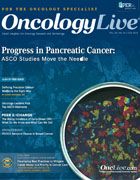Publication
Article
Oncology Live®
Palliative Thoracic EBRT With Concurrent Chemotherapy Is an Option for Incurable NSCLC
Author(s):
A review of available evidence has led the American Society for Radiation Oncology to issue a strong recommendation for use of concurrent chemotherapy with thoracic external beam radiation therapy in a subset of patients with incurable stage III non–small cell lung cancer.
Benjamin J. Moeller, MD, PhD, associate professor of oncology and urology at Johns Hopkins Medicine

Benjamin J. Moeller, MD, PhD
Although few clinical trials have addressed the use of concurrent chemotherapy (CC) with thoracic external beam radiation therapy (EBRT) in non—small cell lung cancer (NSCLC), a review of available evidence has led the American Society for Radiation Oncology (ASTRO) to issue a strong recommendation for use of CC with EBRT in a subset of patients with incurable stage III NSCLC.1 However, ASTRO refrained from recommending the use of CC with EBRT in stage IV NSCLC, owing to a lack of clinical studies of its value.
“Recent data establish a rationale for CC with palliative thoracic EBRT for a well-defined subset: those with incurable stage III NSCLC who are candidates for chemotherapy,” lead author Benjamin J. Moeller, MD, PhD, and colleagues wrote. Candidates for CC should also have an Eastern Cooperative Oncology Group (ECOG) performance status of 0 to 2 and a life expectancy of at least 3 months.
For these patients, a platinum-containing chemotherapy doublet administered concurrently with moderately hypofractionated palliative thoracic radiation therapy is recommended over either treatment alone. “For all other patients with incurable NSCLC, data remain insufficient to support CC with palliative thoracic EBRT,” wrote Moeller of the Department of Radiation Oncology, Levine Cancer Institute-Mallard Creek in Charlotte, North Carolina.
Practical Radiation Oncology published the new guideline, “Palliative thoracic radiation therapy for non—small cell lung cancer,” online in April. The new guidelines are an update to recommendations made in 2011. ASTRO concluded at that time that the medical literature did not support CC with palliative intent/fractionated radiotherapy.2 When the 2011 guidelines were formulated, authors reviewed only 1 randomized controlled trial, published in 1997 by Ball et al, which explored CC and thoracic EBRT for patients with incurable NSCLC.3 Based on those results, ASTRO recommended against CC and thoracic EBRT in patients with lung cancer.
Table. Guidelines for Concurrent Chemotherapy With Palliative Thoracic EBRT
ECOG indicates Eastern Cooperative Oncology Group; EBRT, external beam radiation therapy; NSCLC, non—small cell lung cancer; PS, performance score.
The authors of the current guideline say the prior findings were limited because eligibility was poorly defined and because the Ball investigators used 5-fluorouracil alone as the chemotherapy agent. Subsequent research has established platinum-containing chemotherapy as the superior choice for treating NSCLC.Since the original guidelines were published, 2 studies of note have emerged that the guideline authors said were key to their updated recommendations. In the first, a phase II study by Nawrocki et al, 99 patients with incurable stage III NSCLC were randomly assigned 1:1 to either 3000 cGy administered in 10 fractions or the same radiation dose delivered concurrently with the third of 3 cycles of 80 mg/m2 of cisplatin on day 1 and 25 mg/m2 of vinorelbine (Navelbine) on days 1 and 8. Eligible patients had an ECOG performance status of 0 to 2.4
Investigators concluded that the addition of chemotherapy improved median overall survival (OS; 12.9 vs 9 months). OS was also superior in the chemotherapy arm at 1 year (57% vs 25%) and 2 years (24% vs 6%). Chemotherapy was associated with a much higher rate of grade 3/4 neutropenia (22% vs 0%), but investigators did not observe increases in other high-grade toxicities.
In the phase III Strom trial, 191 patients with incurable stage III NSCLC were assigned 1:1 to 4 cycles of 5 AUC of carboplatin on day 1 and 60 mg/m2 of vinorelbine on days 1 and 8 alone or 4200 cGy of EBRT administered in 15 fractions delivered concurrently with cycle 2 of the same chemotherapy regimen.5
An ECOG score ≥2 was required for eligibility, but nearly 80% of patients had a score of 0 to 1. No patient had an ECOG score ≥3.
Chemotherapy improved median OS (12.6 vs 9.7 months), 1-year OS (53% vs 34%), and 2-year OS (28% vs 7%). Follow-up results showed that chemotherapy helped maintain quality of life (QOL), social functioning, and physical functioning scores.
CC doubled the rate of grade 3 esophagitis (30% vs 15%), but there were no grade 4 adverse events (AEs) observed. Rates of grade 5 AEs were rare and similar between the treatment groups.
Concurrent Chemoradiation Is Not an Option for Patients With Stage IV NSCLC
“Toxicity concerns merit careful attention when patients are being treated with palliative intent; however, the QOL data from the Strom study place these toxicity findings in an important context, suggesting there is a temporary tradeoff in QOL during chemoradiation that is offset by gains in global QOL scores over time, presumably related to improved durability of symptom palliation from more aggressive therapy,” Moeller et al wrote. “These gains will be larger for those with longer survival times, underscoring the importance of not extrapolating these findings beyond those patients matching key eligibility criteria in these studies.”For patients with stage IV disease, the guidelines strongly caution against routine use of CC, concluding that it “should remain primarily reserved for clinical trials or multi-institutional registries.” Moeller et al wrote that there is no level 1 evidence supporting CC in this patient population. There are available data showing an improvement in survival compared with historical controls, but those results are difficult to interpret because they are nonrandomized and recent database analyses have not found a similar survival benefit.
Moreover, because patients with stage IV disease have a median survival that is half that of patients with stage III disease, they are unlikely to get the QOL improvements associated with CC. “As such, we feel the current available data do not support the routine use of [CC] with palliative thoracic EBRT for patients with stage IV NSCLC, and we graded this recommendation as ‘strong,’ in spite of the low quality of evidence, based on the significant risks of patient harm associated with CC in this setting,” Moeller et al wrote.
References
- Moeller B, Balagamwala EH, Chen A, et al. Palliative thoracic radiation therapy for non-small cell lung cancer: 2018 Update of an American Society for Radiation Oncology (ASTRO) Evidence-Based Guideline [published online April 4, 2018]. Pract Radiat Oncol. doi: 10.1016/j.prro.2018.02.009.
- Rodrigues G, Videtic GMM, Sur R, et al. Palliative thoracic radiotherapy in lung cancer: An American Society for Radiation Oncology evidence-based clinical practice guideline. Pract Radiat Oncol. 2011;1(2):60-71. doi: 10.1016/j.prro.2011.01.005.
- Ball D, Smith J, Bishop J, et al. A phase III study of radiotherapy with and without continuous-infusion fluorouracil as palliation for non-small-cell lung cancer. Br J Cancer. 1997;75(5):690-697.
- Nawrocki S, Krzakowski M, Wasilewska-Tesluk E, et al. Concurrent chemotherapy and short course radiotherapy in patients with stage IIIA to IIIB non-small cell lung cancer not eligible for radical treatment: Results of a randomized phase II study. J Thorac Oncol. 2010;5(8):1255-1262. doi: 10.1097/JTO.0b013e3181e15d33.
- Strom HH, Bremnes RM, Sundstrom SH, Helbekkmo N, Flotten O, Aasebo U. Concurrent palliative chemoradiation leads to survival and quality of life benefits in poor prognosis stage III non-small-cell lung cancer: a randomised trial by the Norwegian Lung Cancer Study Group. Br J Cancer. 2013;109(6):1467-1475. doi: 10.1038/bjc.2013.466.




























%20(2)%201-Recovered-Recovered-Recovered-Recovered-Recovered-Recovered-Recovered-Recovered-Recovered-Recovered-Recovered-Recovered-Recovered-Recovered-Recovered-Recovered-Recovered.jpg?fit=crop&auto=format)
%20(2)%201-Recovered-Recovered-Recovered-Recovered-Recovered-Recovered-Recovered-Recovered-Recovered-Recovered-Recovered-Recovered-Recovered-Recovered-Recovered-Recovered-Recovered.jpg?fit=crop&auto=format)
